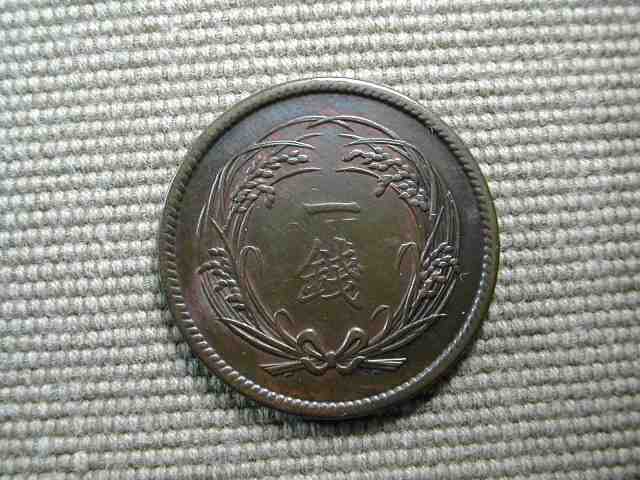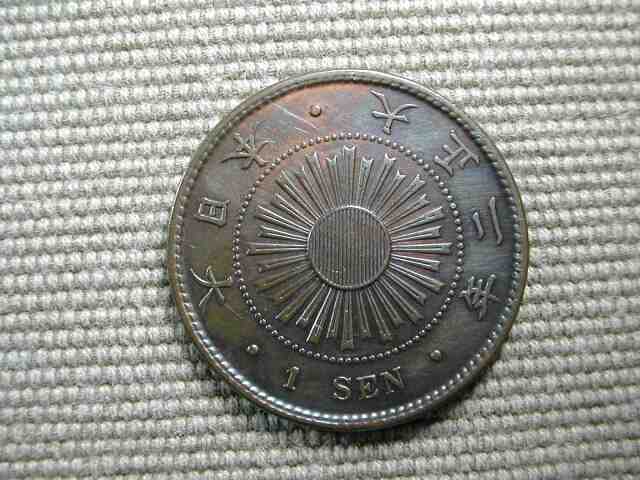Rice 1 Sen (Bronze)
稲一銭青銅貨


Year: Taisho 2 7.05g 27.95mm
Data
- Issued / Banned: Meiji 30 (1897) / Showa 28 (1953)
- Manufacturing Period: Meiji 31 (1898) - Taisho 4 (1915)
- Number of Mintage: 65,500,00
- Material: Copper:950 Tin:40 Zinc:10
- Diameter: 27.878 mm
- Weight: 7.128 g
- Design: Face - Ear of rice plant, Back - Rising sun
History of Issuance
- The issuance of Dragon 1 Sen which started in Meiji 6 were interrupted in Meiji 21. Japanese government promulgated an updated currency law in Meiji 30 which adopted a gold standard system which were becoming the standard in the great powers of the world.
- The stipulated original design in Meiji 30 is the same as Dragon 1 Sen and only the material was changed, however, the deign was reviewed when it was issued in Meiji 31.
- The design was brand new one and simplified. For the face, the ear of rice plant was adopted instead, and the rising sun is used instead of Dragon. "Hundred for One Yen" was deleted maybe because the unit "Sen" was already widely understood among the people.
- It is said the the reason why the design of dragon was not used is that the dragon was thought to be symbol of Chinese emperor. After China (Qing Dynasty) was defeated in First Opium War in 1840 by the powers of western countries, the relationship between China and Japan was getting worse. Finally in 1894, Sino-Japanese War (called Japan-Qing War in Japan) occurred over the domination of Korea.
- In the view point of material, the content of tin was increase from 1 % to 4 % which gives durability to wear and was being common in the world. Copper alloy which contains over 2% is generally classified to Bronze in Japan and this coins is grouped to bronze coins. This composition was the standard of the world for copper alloy coins in those days.
- In 1914 (Taisho 3) WW I broke. Main front of the war was Europe and a great economic boom has come to Japan. It caused the extreme inflation and as a result, the value of metal for this coin was about to exceed the face value. Issuance of this coin was stopped and relay to small one, "Paulownia 1 Sen".
Rarity
- The government took priority over the issuance of gold and silver coins, and sufficient Dragon 1 sen coins were circulated, so the number of mintage is not so high, 1/7 of Dragon 1 Sen although this coin was produced for 20 years.
- A little bit more expensive than Dragon 1 Sen, common year and VF grade coin can be purchased for 300 or 500 yen. Meiji era coins are relatively expensive compared to Taisho era. Meiji 39, 42 and 44 would exist but some kind of pattern coins and not circulated.
Comments
Around 30 year passed after new government by Emperor started and the thought of reverence for Emperor would be already prevailed. Chrysanthemum of the imperial crest are not used for this coins.
Other coins in this period
- 円形銀塊(新一円銀貨)
- Dragon 50 Sen (Silver) J
- Rising Sun 50 Sen (Silver) J
- Dragon 20 Sen (Silver) J
- Rising Sun 20 Sen (Silver) J
- Dragon 10 Sen (Silver) J
- Rising Sun 10 Sen (Silver) J
- Rice 5 Sen (Cupronickle) J
- 5 Rin (Bronze)
Released: Apr 25, 2022


 Move to Home(J)
Move to Home(J)